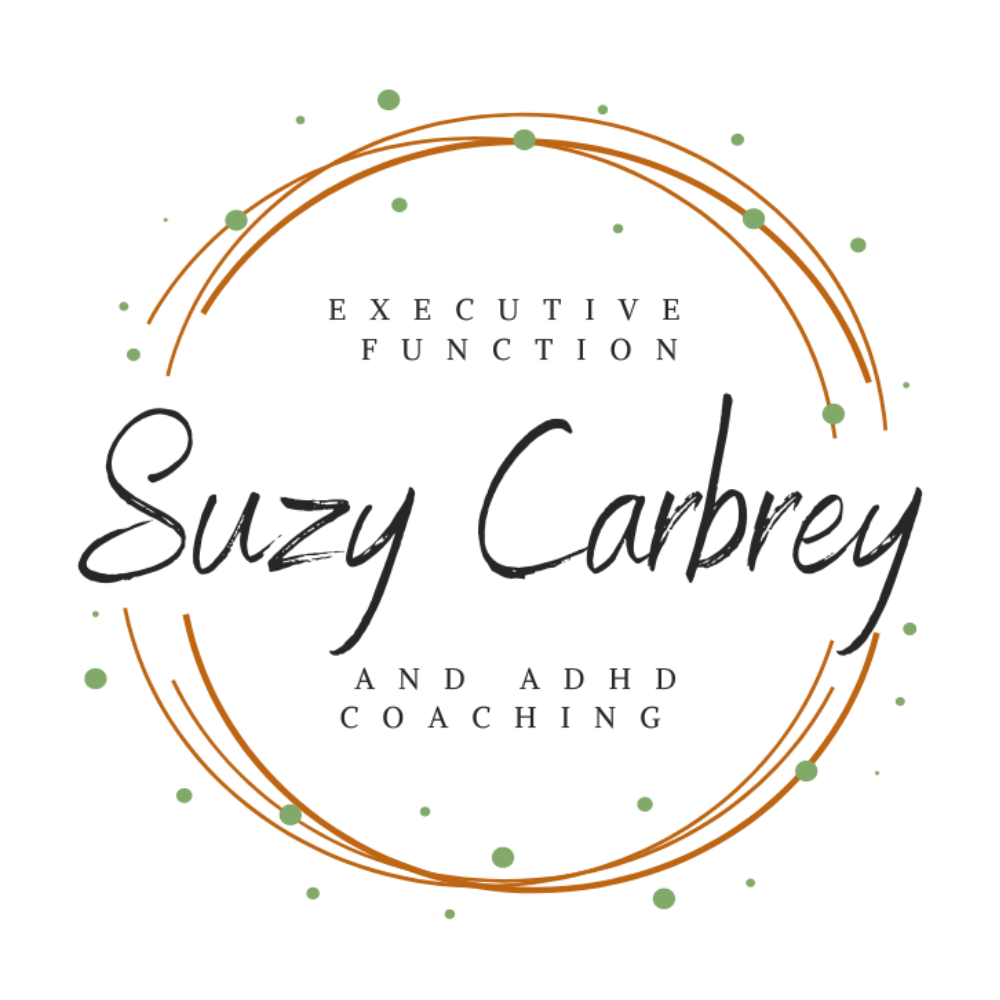Have you ever found yourself scrambling to get out the door in the morning, only to realize you left your phone charger behind? Or maybe you struggle to juggle work, home, and personal projects, feeling like you’re constantly behind no matter how hard you try. These challenges often stem from executive functioning, the brain’s ability to plan, organize, and follow through with tasks effectively. For example, you might find it hard to start writing a report even though the deadline is approaching, or you might forget instructions halfway through a task.
What is Executive Functioning?
Executive functioning manages your brain’s resources, it’s what helps you get things done. These mental skills allow you to plan, organize, stay focused, and regulate emotions when things don’t go as expected. Think of executive functioning as the tools that help you juggle daily responsibilities, whether at work, at home, or in relationships.
When executive functioning is strong, you feel in control of your life. You can set goals and follow through, shift between tasks smoothly, and manage stress without feeling overwhelmed. But when these skills are weak or inconsistent, life can feel chaotic. You might struggle with procrastination, forget important details, or feel easily frustrated when plans change.
Neuroscientists and psychologists often break executive functioning down into specific skills. One widely used framework, the Dawson & Guare Model, identifies 12 core executive functions:
- Emotional Control: Managing feelings and reactions in stressful situations.
- Task Initiation: Getting started on tasks without excessive procrastination.
- Time Management: Using time wisely and understanding how long things take.
- Organization: Keeping track of tasks, plans, and important information.
- Stress Tolerance: Handling pressure and setbacks without feeling overwhelmed.
- Planning & Prioritization: Deciding what’s most important and making a clear plan.
- Goal-directed persistence: Sticking with something even when it’s difficult.
- Working Memory: Remembering and using information while working on a task.
- Mental Flexibility: Adapting when things don’t go as planned.
- Response Inhibition: Thinking before acting and avoiding impulsive choices.
- Sustained Attention: Staying focused, even on long or boring tasks.
- Metacognition: Thinking about your own thinking to improve how you work.
If you’ve ever called yourself “lazy” or labeled yourself a procrastinator, it might not be about motivation, it could be an executive functioning challenge. Instead of feeling guilty or stuck, understanding which skills are difficult for you can help you develop strategies to work with your brain, rather than against it.
The State-Story-Strategy Framework: A Practical Approach
To improve executive functioning, it’s helpful to break the process down into three parts: State, Story, and Strategy.
State:
How you feel in the moment significantly affects how well you function. If you’re stressed, exhausted, or overwhelmed, it’s much harder to focus, plan, and follow through. Managing your nervous system and energy levels through proper rest, movement, and sensory regulation creates a solid foundation for executive functioning. This might include getting enough sleep, going for a walk, or engaging in mindfulness practices like deep breathing exercises.

Story:
The way we talk to ourselves matters. If you believe you’re bad at time management or that you’ll never be organized, those narratives will shape your actions. Shifting self-talk from negative (“I’m always behind”) to constructive (“I’m working on time awareness”) can help you engage with tasks more effectively. For example, instead of thinking “I’m going to mess this up,” try “I’ll do my best, and that’s what matters.”
Strategy:
Once your state is regulated and your internal narrative is constructive, you can apply tools to support executive functioning. This might include using a planner, breaking tasks into small steps, setting reminders, or creating structured environments that reduce distractions. For example, if you struggle with task initiation, try the “two-minute rule.” If a task takes less than two minutes, do it immediately.
How Sensory Processing Affects Focus and Productivity
Have you ever noticed how some people can work in a bustling coffee shop, while others need total silence? Or why some people tap their foot or chew gum while working, while others find that kind of movement distracting? That all comes down to sensory processing, how our brains take in and respond to the world around us.
Winnie Dunn’s Model of Sensory Processing explains that people tend to fall into four categories based on how much sensory input they need (or can handle) to stay focused and functional:
Bystanders:
These people need more sensory input to stay engaged but don’t actively seek it out. They might not notice background noise, a cluttered desk, or a bright screen, but they also might zone out if their environment is too still or quiet.
Seekers:
These individuals crave sensory input and focus better when they can move, fidget, or engage their senses. You might be a seeker if you work best while pacing on phone calls, tapping a pen, or using a standing desk.

Sensors:
Sensors are highly aware of their surroundings and can be easily overwhelmed by too much noise, bright lights, or chaotic spaces. If you’ve ever been completely thrown off by a coworker’s loud typing or struggled to focus when a room feels cluttered, you might fit this category.
Avoiders:
Avoiders actively limit sensory input to maintain focus and calm. They might prefer working alone, using noise-canceling headphones, or keeping their environment minimalist to avoid distractions.
Why This Matters for Your Productivity
Understanding how your brain processes sensory input can help you create a workspace and daily routine that works with your brain rather than against it. If you’re a sensor or avoider, reducing distractions (like using earplugs or adjusting lighting) can help you stay focused. If you’re a seeker or bystander, adding movement, like taking stretch breaks, using a fidget tool, or even playing background music, could boost your engagement. Avoiders might benefit from using apps that minimize visual distractions on computer screens.
Instead of forcing yourself to work in an environment that doesn’t suit your brain, try adjusting your space or habits to match your sensory needs. When you do, focusing, getting things done, and managing your time can feel way easier.
How Your Nervous System Affects Focus and Follow-Through
If you’ve ever struggled to focus, follow through on tasks, or feel motivated, it might not be about willpower but about your nervous system regulation. When your brain feels safe and regulated, it’s easier to plan, organize, and get things done. But when you’re stressed, overwhelmed, or emotionally drained, even simple tasks can feel impossible.
Dr. Stephen Porges’ Polyvagal Theory explains that our nervous system shifts between three key states:
- Ventral Vagal (Calm & Engaged): This is the “sweet spot” for productivity. In this state, you feel present, focused, and capable of following through on tasks. Your brain is open to problem-solving, planning, and making thoughtful decisions.
- Sympathetic (Fight or Flight): When stress kicks in, your brain switches to survival mode. Your heart might race, your mind jumps from task to task, and you feel scattered, impulsive, or overwhelmed. Productivity takes a hit because your brain is too busy dealing with threats (even if that “threat” is just a long to-do list).
- Dorsal Vagal (Freeze & Shutdown): When stress becomes too much, your nervous system might shut down. This can feel like exhaustion, brain fog, or just wanting to avoid everything. You might scroll on your phone for hours, procrastinate, or feel stuck in a cycle of inaction.

How to Regulate Your Nervous System for Better Focus
Since focus and follow-through depend on being in that calm and engaged state, the key is learning what anchors you (keeps you regulated) and what triggers you (throws you off). When you’re in the sympathetic state, try taking short breaks to calm down before returning to a task. If you’re in the dorsal vagal state, engage in gentle movement or spend time in nature.
Anchors are things that make you feel safe, grounded, and capable. These might include deep breathing or meditation, a familiar routine, movement (walking, stretching, dancing), supportive relationships, or a clutter-free, organized space.
Triggers are things that send you into stress or shutdown mode. Common ones include tight deadlines or last-minute surprises, too much clutter or noise, multitasking or frequent interruptions, poor sleep, or lack of food/water.
The more you recognize your anchors and triggers, the more you can set yourself up for success. If you know clutter stresses you out, keeping a clean workspace might make focusing easier. If movement helps regulate you, a quick walk before tackling a tough task might be the key to better follow-through.
When your nervous system is on your side, motivation and focus come much more naturally.
The Power of Self-Talk in Executive Functioning
One of the most overlooked but powerful tools for improving executive functioning is self-talk, the internal dialogue we have with ourselves. Cognition and communication are deeply intertwined, and the way we use language in our minds directly impacts our ability to plan, focus, and regulate emotions. In fact, research shows that verbalizing tasks, even silently, can help guide our attention, improve problem-solving, and regulate emotions. Think of self-talk as an internal GPS, it provides your brain with a step-by-step roadmap to stay on track and move forward.
There are different types of self-talk that support executive functioning in specific ways:

Goal-Directed Self-Talk:
Helps with planning and organization by giving your brain clear instructions for action.
Example: “First, I’ll check my schedule, then prioritize.”
Instructional Self-Talk:
Keeps you focused and engaged in the task at hand, preventing rushing and improving execution.
Example: “I need to slow down and follow the steps.”
Motivational Self-Talk:
Encourages persistence, boosting confidence when a task feels challenging or overwhelming.
Example: “I’ve done this before, I can do it again.”
Problem-Solving Self-Talk:
Supports flexibility, helping you work through obstacles without getting stuck.
Example: “If I get stuck, I’ll break it down.”
Refocusing Self-Talk:
Reduces the impact of distractions by helping you recall what you were doing and regain momentum.
Example: “Back to the task, what was I doing?”
Growth-Mindset Self-Talk:
Reinforces resilience, reminding you that progress takes time and that setbacks are part of learning and growth.
Example: “I’m still learning, I’ll improve with practice.”

By becoming more intentional with self-talk, you can strengthen executive functioning skills, improve follow-through, and reduce frustration in daily tasks. The next time you find yourself struggling with focus, motivation, or problem-solving, try checking in with your internal dialogue; it might just be the tool you need to get back on track.
Practical Strategies to Support Executive Functioning
While understanding the different facets of executive functioning is crucial, it’s equally important to have practical strategies to apply this knowledge in everyday life. Here are some ways to support your executive functioning:
- Use External Supports: Don’t rely solely on your memory. Planners, visual reminders (like sticky notes or whiteboards), and alarms can help offload cognitive demands and keep you organized.
- Break Tasks Down: Instead of overwhelming yourself with a large task, break it into smaller, more manageable steps. This makes the overall goal seem less daunting and allows you to celebrate small wins along the way.
- Create Routines: Consistent habits reduce decision fatigue and make follow-through easier. When you have a routine, your brain doesn’t have to work as hard to figure out what to do next.
- Limit Distractions: Identify environmental triggers and make adjustments. This might involve using headphones, turning off notifications, or setting up a designated workspace free from clutter and interruptions.
- Build Transitions into Your Day: Shifting from one activity to another is easier with buffer times. For example, schedule a five-minute reset between tasks to clear your head and prepare for what’s next.
- Adjust Your Self-Talk: Be mindful of your internal dialogue. Instead of saying “I can’t do this,” try “What’s one small step I can take?” This shift in perspective can make a big difference in your motivation and ability to get started.
- Recognize Your Sensory Needs: Adjust your environment to support focus. This might involve adjusting lighting and noise levels or incorporating movement into your day, depending on your sensory preferences.
- Manage Energy, Not Just Time: Prioritize sleep, hydration, and movement to sustain productivity. When your energy levels are high, you’re better equipped to focus and follow through on tasks.
- Develop a Planning Routine: Setting aside time each week to review priorities and create a plan reduces last-minute scrambling and helps you stay on top of your responsibilities.
- Practice Self-Compassion: Progress takes time, and setbacks are a normal part of the journey. Be kind to yourself, acknowledge your efforts, and celebrate small victories along the way.

Final Thoughts
Executive functioning challenges don’t mean you’re incapable or lazy, they simply mean your brain benefits from specific supports and strategies. By understanding how your brain works, regulating your nervous system, and using tools that support your unique needs, you can reduce overwhelm and move through life with more ease and confidence.

Improving executive functioning is a lifelong process, but with the right mindset and strategies, you can navigate daily life with greater ease and effectiveness. Start small, experiment with different techniques, and celebrate progress along the way!
Learn more with Online Coaching for Executive Functioning / ADHD
Ready to gain control and enhance your executive functioning? As an experienced and compassionate coach, I specialize in providing support for executive functioning and ADHD. To embark on your journey, please reach out to me at 708-264-2899 or email hello@suzycarbrey.com to schedule a FREE 20-minute discovery call consultation.
With a background as a speech-language pathologist, I have a strong foundation in executive functioning coaching. My graduate degree program in SLP placed a significant emphasis on cognition, including executive functions, and I have years of experience in medical rehabilitation, providing cognitive-communication therapy. Additionally, I have completed an ADHD Services Provider certification program, I am Solutions-Focused Brief Therapy Diamond Level 1 certified and I am trained in the Seeing My Time® executive functioning curriculum.
Experience the convenience and effectiveness of online coaching, backed by studies that demonstrate equal results to in-person services. Parents, professionals, and emerging adults love the convenience and privacy of receiving coaching from their own homes.
Whether you reside in Chicago, Milwaukee, Indianapolis, Kansas City, or anywhere else around the globe, I am here to assist you. Schedule your discovery call consultation today, and I eagerly anticipate the opportunity to work with you!
Please note that although I am a certified speech-language pathologist, all services Suzy Carbrey LLC provides are strictly coaching and do not involve clinical evaluation or treatment services. If you require a formal speech therapy evaluation and treatment, please inform me, and I can provide appropriate recommendations.

